
If you’re sitting for long hours and suffer from restricted movement or pain in your lower back, it’s possible that an anterior pelvic tilt is to blame.
This condition severely reduces athletic potential, functional movement, and of course, can lead to chronic pain in the back and lower limbs.
I know, big butts are popular these days, and you may think sticking your butt out is a sure fire way to gain attention from the opposite sex (well, to be honest, if you’re female it probably will)…
HOWEVER, forcing your pelvis into an anterior pelvic tilt is training your body to adapt to a bad position. And while waving your butt in the air will get you attention, it’s probably not the kind of attention you want.
Today, we’re going dive into the anterior pelvic tilt and you’ll come out of it understanding:
- What an anterior pelvic tilt is
- Common causes of anterior pelvic tilt
- The problems associated with this pelvic position
- How to determine if you actually have an anterior pelvic tilt
- An effective 6 minute routine to fix it
Even if you don’t have an anterior pelvic tilt, understanding this information is critical to prevent yourself from developing one and all of the associated problems in the future. [However, head over here if you’ve got a posterior pelvic tilt instead.]
What is Anterior Pelvic Tilt?
Anterior pelvic tilt is a common postural fault. This is where the pelvis rotates anteriorly on its axis causing the lumbar spine to overly arch and push the butt backwards.
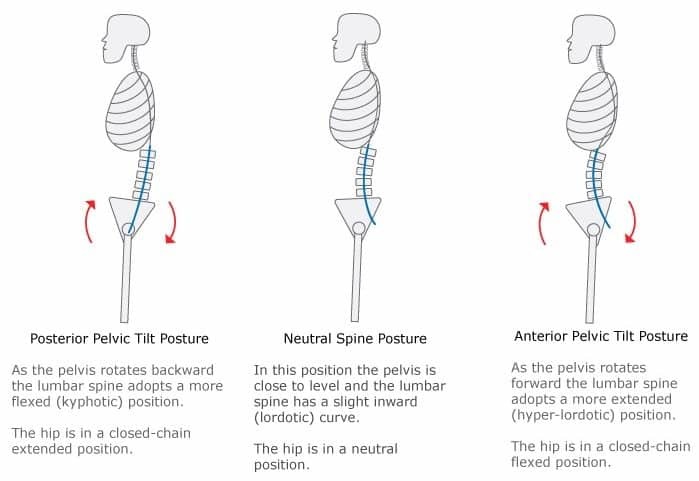
Ever seen a person walking their dog and thought “Damn, when did Donald Duck move into the neighborhood?”
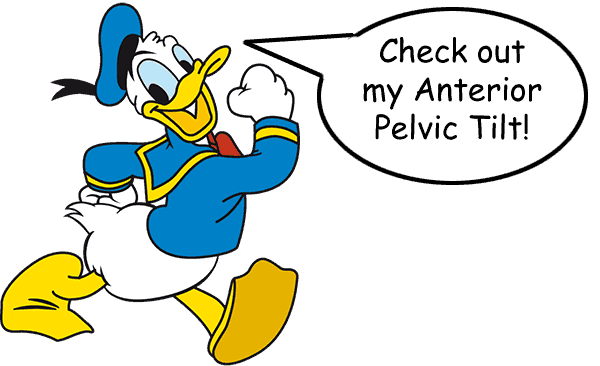
That protruding backside is something called hyperlordosis (excess arching of the lumbar spine) and it’s a tell tale sign of anterior pelvic tilt.
Anterior pelvic tilt is commonly seen in office workers and other people who sit for long hours each day. This is because extended time in certain positions, like sitting, will make the muscles adapt to that position.
Sitting in a flexed hip position for long periods shortens muscles like the psoas and weakens the glutes, which affect pelvic stabilization and tilt. [1]
Another group of people who experience anterior pelvic tilt are those that carry a few extra pounds around the belly. [2], [3]
If this sounds like you, the excess weight located in your belly is pulling your lumbar spine into extension and your pelvis anteriorly.
Now, let’s take a look at what’s happening on an anatomical level.
What Causes Anterior Pelvic Tilt?
Anterior pelvic tilt is caused by a muscular imbalance in the lower region of the body and is also known as Lower Crossed Syndrome. This condition was made famous by the brilliant, and late, Dr Vladimir Janda, which is why it’s also sometimes referred to as Janda’s Syndrome.
Lower crossed syndrome is defined by a pattern of weakness and tightness in the muscles located in the anterior (front) and posterior (back) of the lower body.
This pattern causes the pelvis to tilt anteriorly, as tight muscles exert a stronger pull against lax muscles, moving the pelvis out of its natural position.
The muscles in this relationship include:
Tight Muscles:
- Psoas
- Iliacus
- Tensor Fasciae Latae
- Rectus Femoris

Thoracolumbar Extensors:
- Erector Spinae
- Multifidus
- Quadratus Laborum (QL)
- Latissimus Dorsi (the Lats)
Weak Muscles:
Stabilizing Abdominal Muscles
- Rectus Abdominis
- Internal Obliques
- External Obliques
- Transverse Abdominis
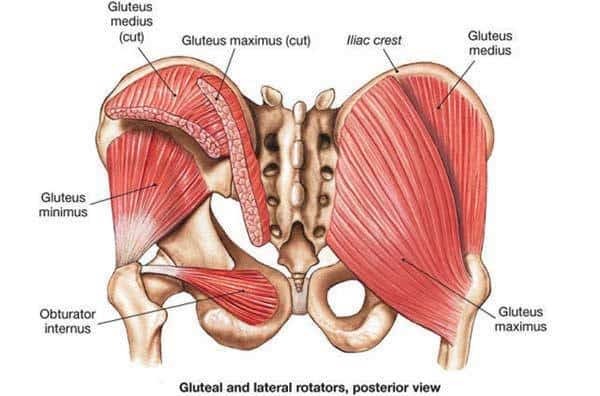
I know, that’s a lot of anatomical information to digest, so to make things easier I’ve included the image below to give you a visual representation showing how this pattern of muscular imbalance works.
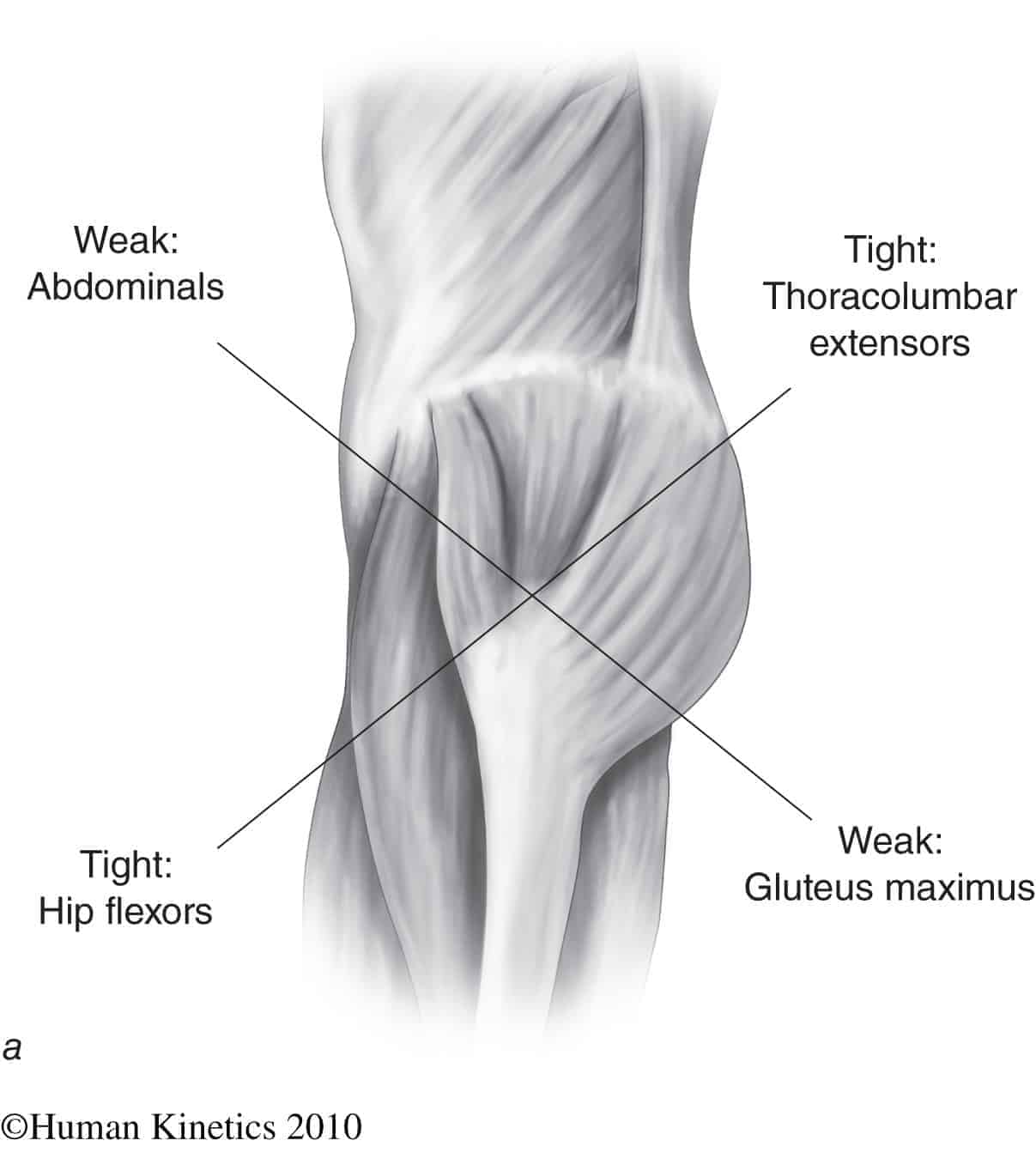
(Image courtesy of Physio-pedia.com)
From this image, you can see a diagonal line connecting the weak muscles of the anterior to the posterior side, and the tight muscles of the posterior to the anterior side of the lower body. Hence, lower crossed syndrome.
Lower crossed syndrome is kind of like that game of tug of war your high school gym teacher made you play. Except, in this situation one team is pulling the rope, while the other team is checking out the hot new foreign exchange student.
Not only will an anterior pelvic tilt affect you aesthetically, it also affects your capacity for functional movement.
Real World Problems Caused By Anterior Pelvic Tilt
Sprinters, weightlifters and other athletes actually benefit from an anterior pelvic tilt when trying to generate power through hip extension. However, it’s a different story for people who have this pelvic tilt due to a muscular imbalance.
When people default into an anterior pelvic tilt because of a muscular imbalance, it’s because the hip flexors have shortened and the glutes are inhibited. An anterior tilt will help most athletes generate power, however in cases where the glutes are weak it may result in the body finding other neuromuscular strategies for hip extension and lower limb control. [4]
For everyone else, anterior pelvic tilt can cause issues not only in the pelvis, but also in the lumbar spine and lower limbs, like:
- Pressure on the anterior portion of your lumbar discs
- Knee pain and injury due to altered hip and knee biomechanics
When the pelvis tilts anteriorly, the natural lordotic curve (arch of the lumbar spine) increases and creates an assault on the vertebral discs.

When lifting objects or performing exercises like squats, hyperlordosis causes the vertebrae to move closer together on the posterior side applying more of a compressive force on the anterior side of the discs.
Normally, in heavy lifting the body will try to protect the spine by slightly flattening the lumbar spine. [5]
Lifting with a fixed anterior pelvic position limits this ability to protect the spine and can cause damage to the discs.
Excess lumbar lordosis can also compress the sciatic nerve causing pain, tingling or numbing sensations in the lumbar region and down the back of the legs.

This is because when the pelvis is tilted anteriorly, the gap known as the greater sciatic notch, where the sciatic nerve passes through the vertebrae, becomes smaller and can get compressed against it.
Anterior pelvic tilt can also result in internal hip rotation and in a domino effect, valgus (knock) knees and over pronation of the foot.
This misalignment can result in impingement at the hip, medial knee pain, medial ankle pain or plantar fasciitis. [6]
Definitely not fun, so what can we do?
How to Test for Anterior Pelvic Tilt
First we need to determine if we actually have anterior pelvic tilt or not.
It’s a very simple test that involves measuring the angle between your:
- Posterior Superior Iliac Spine (PSIS)
- Anterior Superior Iliac Spine (ASIS)
You can measure the ASIS/PSIS angle yourself, standing sideways in front of a mirror, or, alternatively you can ask a friend to help you. There’s going to be some touching involved in this test, so make sure it’s a good friend assisting you (don’t just ask someone at the bus stop to help you out as a way of killing time – that can be creepy).
- Find the PSIS, which is located just below the dimples of your lower back and move your hand to the right (or left) palpating your fingers until you find the bony poin
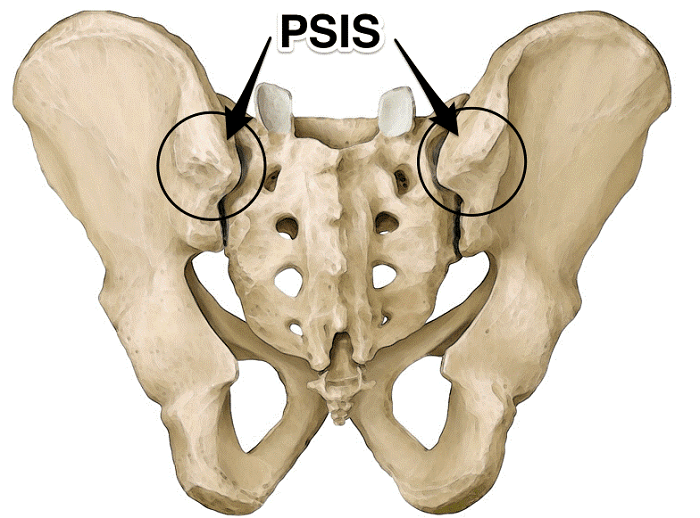
2. Locate the ASIS which is the super bony part in the front of your hips roughly inline with your PSIS
3. Draw an imaginary line from your PSIS to your ASIS
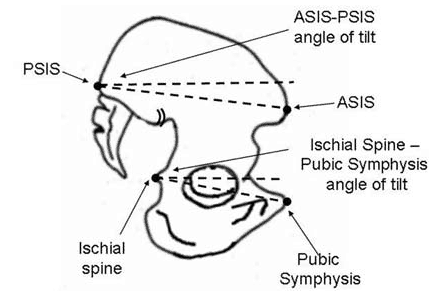
A neutral pelvic tilt will have a slight descending line from the PSIS to the ASIS with about half an inch difference between them, give or take. Women will naturally have a larger difference from their PSIS to their ASIS compared to men, however the difference should still be around the half an inch mark.

If you find that you have a difference closer to 2 inches or greater, it indicates you likely have an anterior pelvic tilt.
If you’ve done the test, and found that your pelvis was in a good neutral position, congratulations.
But, if you’ve discovered an anterior tilt and people are quacking at you when you walk by, it’s a good idea to do something about it and here’s that something…
The 6-Minute Anterior Pelvic Tilt Exercise Program
With excessive anterior pelvic tilt, the goal should be to stretch and mobilize the tight areas first. Then, strengthen and activate ALL of the inhibited muscles responsible for posterior pelvic tilt to change the resting posture.
Below, I have provided you with a quick 6-minute routine to help you reset your pelvis into neutral position and treat the symptoms of anterior pelvic tilt.
This routine works to:
- Stretch and lengthen the muscles that have become short and tight
- Release anything that may be restricting the mobility of the hip capsule
- Activate the muscles that have become weak and inhibited
- Train and improve neural control in functional movements so that the proper patterns are ingrained into the movement
FREE DOWNLOAD: 6 MINUTE ANTERIOR
PELVIC TILT ROUTINE CHEATSHEET

0-1st Minute: Child Pose
Take the first minute to relax and stretch the lumbar extensors using the child pose.

- Place your hands out in front of you to support your weight as you open your knees to roughly hip width apart
- Exhale as you lower your chest towards your thighs and feel your lumbar begin to lengthen
- Place your forehead on the ground or mat and place your arms underneath you by your sides
- Relax here and make sure you’re breathing deep and comfortably
1st – 3rd Minute: Kneeling Hip Flexor Dual Contract Relax (DCR) Stretch
This stretch encourages activation of the psoas and glute in extension and end range, so that they can perform in these positions rather than passively hang out.
This stretch also uses a band to create a distraction at the hip capsule and free up any restrictions to mobility in that area.

- Take a kneeling lunge position on the ground with your front leg at a 90° angle in front of you
- Attach a band at about knee height to a pole, or some other sturdy structure, and loop the other end of the band around your kneeling leg just under your butt
- Slightly lean forward so that your hip on the side of you kneeling leg is in extension
- Make sure you maintain good neutral posture, chin tuck and shoulders retracted back and down throughout this exercise
- In this extended hip position, imagine your going to drag your knee forward without actually doing it. This will activate the psoas of the kneeling leg while at the same time activating the glute of your other leg. Hold this activation for 10 seconds
- Relax now in the extended position and feel the stretch for 10 seconds
- Now, squeeze the glute on the kneeling leg and use that squeeze to drive your hip forward into the extension
- Focus and squeeze your glutes as tight as possible for 10 seconds
- Relax your glute and hold the extended position for 10 seconds
- Repeat 2 times per side
3rd – 5th Minute: Glute Bridge and Plank Superset
This superset trains the activation of the core muscle in both the prone and supine positions to get the most out of your stabilizer muscles.
Perform this superset while maintaining a slight posterior tilt to help engage and activate the inhibited muscles.
After you feel your pelvic position has normalized you can then attempt this superset with a neutral pelvic tilt.
Glute Bridge:

- To get your mind focused on glute activation, make sure you alternate between contracting and relaxing your glutes before you begin the bridge.
- When you feel like you have good control over your glute contractions, squeeze your glutes and elevate your hips to the sky driving your heels into the ground
- Elevate your hips so that there is a straight line from the top of your chest all the way to the top of the knees and hold for 15 seconds
- Keep the glutes tight and make sure you’re breathing comfortably throughout the exercise
Plank:

- Make sure your shoulders are retracted back and down to set the scapula in position
- Lift your hips off the ground to achieve the plank position with your weight now resting on your forearms and toes
- Squeeze your glutes, quads and abs as tight as you can to activate the stabilizer muscles of your core
- Hold this position for 15 seconds
Repeat this superset 4 times through.
Final Minute: Reverse Lunges in Posterior Pelvic Tilt
For the final exercise, you’re going to perform reverse lunges alternating between legs for a minute straight.
Just like the last superset, you should perform this exercise with a posterior pelvic tilt until you feel your pelvic position has normalized.

- Start in a standing position with our feet hip width apart, neutral posture and your chin tucked
- Take a step back with one leg and make sure your only making contact on the ground with the ball of your foot
- Make sure your hips are facing forward and there is no rotation of the torso or hips in any direction
- Slowly lower your rear knee towards the ground by flexing at the rear knee and the hip of your front leg
- Stop just shy of touching the ground with your knee and hold for a second or so
- Stand up again by driving the heel of your front foot into the ground
- Step forward with your rear leg so your feet are hip width apart again and repeat on the other leg
Don’t forget that it’s important to address lifestyle factors to prevent reinforcing anterior pelvic tilt.
So break up your sitting time with periods of moving around and throw in some of the stretches and exercises during your breaks.
And while this 6 minute routine is great, if you’ve never fully addressed all of the factors that contribute to muscular imbalance syndromes like anterior pelvic tilt, I suggest you first understand what the various factors are (there are NINE) which I outline on this page here, then take the appropriate actions to address them all for ultimate movement longevity.
Original article and pictures take www.precisionmovement.coach site
Комментариев нет:
Отправить комментарий